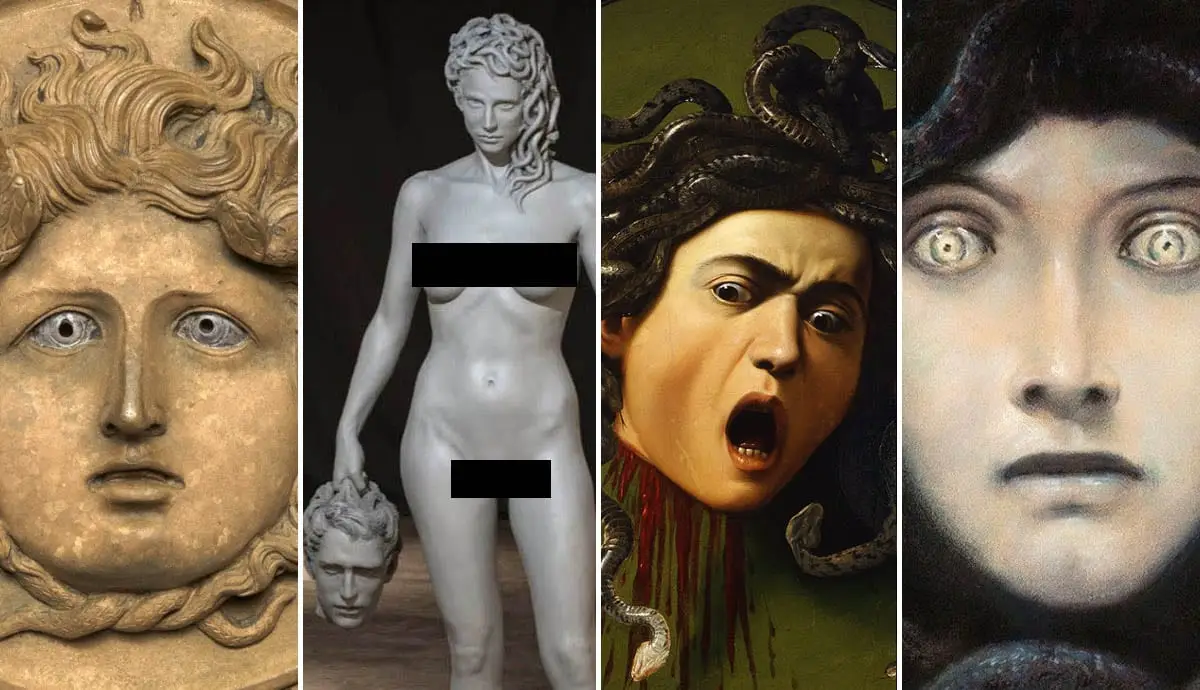The Myth of Medusa: Medusa Art History and Gorgon Depictions
In Greek mythology, Medusa emerged as one of its most formidable figures, her name in Ancient Greek translating to “guardian” or “protectress.”
Often portrayed as a monstrous Gorgon, modern interpretations seek to provide a fresh outlook on Medusa, sometimes through pieces of medusa wall art that reimagine her legacy.
Traditionally depicted as a winged human female adorned with venomous snakes in place of hair, she possesses the formidable ability to petrify anyone who meets her gaze.
Exploring the Myth and Head of Medusa Gorgon
In most renditions of the tale, Medusa meets her demise at the hands of the hero Perseus, dispatched by King Polydectes of Seriphus.
Polydectes desired Medusa’s head in his pursuit to marry Perseus’s mother. Aware of this scheme, the gods intervened to aid Perseus.
Athena provided him with a mirrored shield, Hermes bestowed upon him gold, winged sandals, Hephaestus gifted him a sword, and Hades lent him his helm of invisibility.
As Medusa was the sole mortal among the Gorgons, Perseus could confront her by using the reflection in Athena’s shield to avoid direct eye contact.
At the time of her demise, Medusa carried Poseidon’s child, a tale that adds layers to the interpretation of Medusa in ancient myths. Upon her beheading, Pegasus, the winged horse, and Chrysaor, a giant wielding a golden sword, emerged from her body.
She is the most renowned of the Gorgon sisters, depicted as a winged female creature with snakes for hair, a figure in art that has inspired countless interpretations of Medusa.
Unlike her monstrous siblings, Medusa was sometimes portrayed as remarkably beautiful. She was the sole mortal among the Gorgons, allowing her slayer, Perseus, to defeat her by beheading her. One of the three Gorgons, her tale continues to fascinate.
From her severed neck sprang Chrysaor and Pegasus, her offspring with Poseidon. Medusa’s head, capable of turning onlookers into stone, was given to Athena, who incorporated it into her shield. Alternatively, Perseus is said to have buried it in the marketplace of Argos.
Gaze upon the hauntingly beautiful yet petrifying visage of Medusa, the enigmatic figure from Greek mythology whose legend has captured the imaginations of artists across centuries.
Born from a twisted lineage that intertwined divinity and monstrosity, Medusa’s tale is one of tragedy and empowerment, fear and fascination.
Her serpentine locks capable of turning mortals to stone have rendered her a symbol of both allure and terror, drawing creators into a web of artistic exploration unlike any other.
From ancient frescoes to Renaissance masterpieces, Medusa has served as a muse for generations of artists seeking to unravel the complexities behind her formidable gaze.
Each brushstroke or chisel mark endeavours to capture not just her physical attributes but also the psychological depth she represents—a narrative woven with themes of victimhood, empowerment, and transformation.
As we embark on this visual odyssey through time and artistry, let us peel back the layers shrouding Medusa’s image to uncover the myriad interpretations that have immortalized her in canvas and marble.
Join us in deciphering how this mythical creature continues to transcend mere folklore to embody timeless truths about humanity’s eternal struggle between beauty and beastliness.

Ancient Greek: Medusa in Early Greek Artworks & Greek Mythology
In the realm of ancient Greek art, the enigmatic figure of Medusa often emerged as a symbol shrouded in both fear and power.
Artists of antiquity skillfully captured her essence through intricate details and symbolic representations, often on Greek mythology wall art that adorned the halls of the ancient world.
In pottery and sculptures dating back to as early as the 6th century BCE, we witness Medusa’s visage depicted with serpentine hair writhing like tendrils of chaos, evoking a sense of dread and mystique among viewers.
The Greeks ingeniously intertwined elements of beauty and monstrosity in their portrayals, reflecting the complex dichotomy that defines this mythological being, a theme often explored in greek mythology art.
Within these early artworks, Medusa emerges not merely as a malevolent monster but as a potent symbol embodying notions of femininity and strength, a central figure in art history’s examination of power and vulnerability.
The interpretation of her gaze turning mortals into stone served as a cautionary tale against defying divine authority or succumbing to unchecked hubris.
It is fascinating to observe how ancient artists imbued their renditions with layers of symbolism, hinting at deeper narratives surrounding female empowerment, mortality, and the capricious nature of fate itself.
Through their creative lenses, they crafted visual stories that transcended mere representation to resonate with audiences on profound psychological levels.
In a later rendition of the Medusa myth recounted by the Roman poet Ovid, Medusa begins as a stunningly beautiful maiden, coveted by many suitors due to her allure.
However, when Poseidon violates her in Athena’s temple, the enraged Athena inflicts a punishment upon Medusa.
Athena transforms Medusa’s once beautiful hair into serpents and imbues her visage with such terror that merely glimpsing it would petrify onlookers into stone. In Ovid’s narrative, Perseus regards Medusa’s punishment by Athena as fitting and deserved.
Renaissance Revival: Rediscovering Medusa's Gaze in Art
The Renaissance period heralded a revival of interest in classical mythology, breathing new life into ancient tales and figures, including Medusa, whose story was reinterpreted through the lens of art nouveau.
Artists during this era found inspiration in the stories of gods and monsters, reinventing these myths through their unique creative lens.
One such enigmatic character who graced the canvases of renowned painters was Medusa, the Gorgon with serpents for hair and a gaze that turned men to stone.
In the hands of masters like Caravaggio, her story became not just a myth but an exploration of beauty, danger, and mortality, an interpretation of Medusa that continues to captivate audiences.
Paul Rubens
Peter Paul Rubens’ contemporaries perceived the Medusa beyond a mere terrifying entity, seeing her instead through the lens of Greek myth, where complexity and tragedy abound.
It was viewed as a symbol of stoic reason prevailing over adversaries of virtue and as a representation of the potential to govern passions and exhibit stoic composure through unwavering realism.
While the intricate depiction of the snakes was likely executed by a specialist, Frans Snyders, the concept originated from Rubens himself.
The intertwined posture of the two serpents on the right likely drew inspiration from contemporary emblems, yet their scientifically accurate portrayal stemmed from
Rubens’ meticulous observation of nature. In certain instances, such as the sinuous snake in the foreground to the right, Rubens may have utilized casts derived from natural specimens to depict Medusa, a method particularly favored in northern Italy.
Caravaggio
Caravaggio’s rendition of Medusa stands as a testament to his skill in capturing raw emotion and dramatic tension within a single frame.
In his depiction, Medusa is frozen at the moment of her demise – her eyes wide with shock, snakes writhing amidst disarrayed locks; it is both captivating and chilling.
The play of light and shadow in Caravaggio’s work adds depth to the narrative, showcasing not just Medusa’s monstrous form but also her humanity in facing an unjust fate.
Through his painting, we are invited to confront our own fears and vulnerabilities mirrored in the petrified faces around her – a poignant reminder of mortality woven into classic mythology’s intricate tapestry.
Modern Interpretations

In the realm of contemporary art, Medusa continues to captivate and inspire artists worldwide, with her enigmatic allure transcending time, as seen in exhibits in places like the Metropolitan Museum of Art.
From vibrant paintings that reimagine her story through a modern lens to innovative sculptures that skillfully portray her mythological essence, creators in various mediums are drawn to unraveling the complexities of this iconic figure.
Galleries and exhibitions across the globe showcase an eclectic array of interpretations, each offering a fresh perspective on Medusa’s narrative.
One such example is the ‘Medusa Reimagined’ exhibition held at a renowned gallery in New York City, where emerging talents and established artists alike showcased their distinctive takes on Medusa’s tale.
Through bold brushstrokes and striking use of color, contemporary painters breathed new life into her character – redefining beauty beyond conventional norms.
In another exhibit at an avant-garde gallery in Paris, visitors were mesmerized by larger-than-life sculptures embodying Medusa’s dual nature – both fearsome and tragic. These pieces served as a vivid interpretation of Medusa in the realm of modern art nouveau. These installations invited viewers to confront their own perceptions of power and vulnerability as reflected through this mythical being..
Psychoanalysis
In 1940, Sigmund Freud’s posthumously published work, “Das Medusenhaupt (Medusa’s Head),” redefined psychoanalysis.
Freud interpreted the terror associated with Medusa as a fear of castration triggered by the sight of female genitalia, particularly that of the mother figure.
He suggested that the classical portrayal of Medusa represents the Oedipal complex, where gazing upon the forbidden mother solidifies illicit desire and instills fear of retribution.
There are no recorded instances of Medusa turning a woman to stone. In contemporary literary criticism, psychoanalysis remains relevant, with interpretations like Beth Seelig’s attributing Medusa’s punishment to unresolved conflicts with her father, Zeus.

Feminism
In the 20th century, feminists revisited Medusa’s portrayal in literature and modern culture, including its adoption as a logo by fashion company Versace, elevating the Medusa head to a contemporary emblem of power.
The name “Medusa” itself has evolved beyond its mythological origins to connote malevolence, despite its initial association with beauty, now often synonymous with “monster.”
Medusa has emerged as a symbol of female rage, prominently featured in feminist publications such as Women: A Journal of Liberation and Woman of Power.
She represents female fury and defiance against patriarchal norms, with her visage serving as a guardian of female power, as seen in Elana Dykewomon’s collection They Will Know Me by My Teeth.
In contemporary pop culture, Medusa embodies feminine rage and rebellion, challenging narratives that prioritise male protagonists, much like the stories of greek god and goddess conflicts in mythology.
Her enduring significance, according to author Stephen Wilk, stems from her portrayal as both fearsome and protective, symbolizing women’s empowerment and defiance against oppression.

Elizabeth Johnston’s essay in The Atlantic highlights Medusa’s relevance in modern politics, particularly during the 2016 presidential election, where she was likened to Hillary Clinton.
Johnston argues that Medusa’s story reflects a rape narrative and victim-blaming, echoing themes present in contemporary American society.
Feminist theorist Hélène Cixous addressed the Medusa myth in her renowned essay “The Laugh of the Medusa.” She contends that men’s interpretations of the myth transformed Medusa into a monstrous figure due to their fear of female desire.
“The Laugh of the Medusa” serves as a rallying cry for women to reclaim their identity through writing, rejecting patriarchal norms in Western society.
Cixous views writing as a powerful tool to liberate women’s sexuality, allowing them to access their innate strength and reclaim control over their bodies and language. She advocates for dismantling the phallogocentric system and empowering women through their bodies and voices.
In Cixous’s perspective, Medusa symbolizes not danger, but beauty and laughter, challenging conventional narratives and reclaiming female agency.
In art, Judy Takács’s painting #Me(dusa)too revisits the Medusa myth in the context of the #MeToo movement, highlighting the issue of rape victim-blaming.
Feminist theorist Hélène Cixous, in her essay “The Laugh of the Medusa,” urges women to reclaim their identity through writing and reject patriarchal constructs.
She celebrates Medusa as a symbol of female empowerment, challenging the notion of female desire as monstrous and reclaiming women’s agency over their bodies and language, akin to the defiance Goddess Athena showed in ancient myths.
Reimagining Medusa Through Contemporary Perspectives
Medusa, a legendary figure in Greek mythology, has inspired countless interpretations in art and literature.
Depicted as a Gorgon, Medusa’s ability to turn those who gazed upon her into stone has captivated artists throughout history.
In Greek art, Medusa’s head is a recurring motif, symbolizing both beauty and danger. From ancient Greek vase-painters to contemporary digital art, Medusa’s image has adorned canvas art, sculptures, and wall decor.
One of the most famous depictions of Medusa is the decapitated head of Perseus, a Greek hero who defeated her.
The myth of Medusa, originally a beautiful maiden, punished by Athena, goddess of wisdom, has been immortalized in fine art and mythology print.
At the Metropolitan Museum of Art, visitors can admire classic Medusa sculptures and contemporary Medusa wall art. Whether it’s a colorful Medusa painting or a gothic Medusa poster, there’s something for every taste in Medusa-themed art.
Explore our selection for the best Medusa ideas and add a touch of Greek mythology to your modern home decor.
In the realm of artistic expression, Medusa’s enigmatic allure continues to captivate audiences, beckoning artists to delve into her essence with renewed vigor.
Among the myriad interpretations discussed earlier, it becomes evident that each brushstroke carries not just pigment but a narrative woven with threads of reverence and revolution.
Reflecting on these diverse portrayals unveils a tapestry where tradition meets innovation in a harmonious dance, challenging preconceived notions and breathing fresh life into ancient tales.
As we traverse through centuries of artistry dedicated to unraveling Medusa’s mysteries, an intriguing interplay emerges between homage and reinvention.
From classical renditions exuding ethereal beauty to avant-garde experiments pushing boundaries of perception, artists find themselves at an intersection where past whispers guide present strokes towards uncharted territories.
This journey transcends mere observation; it invites introspection on how contemporary lenses refract timeless truths, urging us to embrace complexity within simplicity and ambiguity within certainty.
Perhaps, a depiction of Medusa could serve as the perfect living room wall art, prompting such introspection.
Through meditative contemplation sparked by visual provocations lies an invitation to co-author the ever-evolving narrative of Medusa—to unshackle her from static portrayals and witness her metamorphosis through kaleidoscopic visions that echo across epochs.





